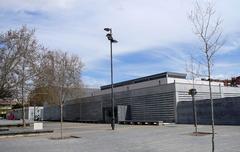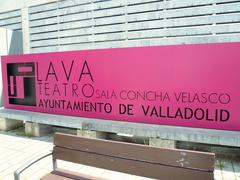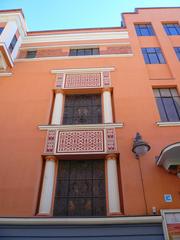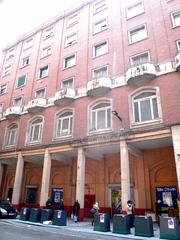
Panteón de Hijos Vallisoletanos Ilustres: Visiting Hours, Tickets, and Valladolid Historical Sites Guide
Date: 03/07/2025
Introduction
Nestled within the tranquil grounds of the Cementerio de El Carmen in Valladolid, Spain, the Panteón de Hijos Vallisoletanos Ilustres stands as a distinguished memorial to the city’s most influential figures. Established at the turn of the 20th century, this pantheon embodies Valladolid’s deep-rooted civic pride and cultural heritage. It is the final resting place for renowned poets, novelists, artists, and thinkers such as José Zorrilla, Miguel Delibes, and Rosa Chacel, among others. Beyond its commemorative purpose, the pantheon’s architecture and artistic features provide a solemn yet inspiring destination for cultural travelers and history enthusiasts (El Norte de Castilla; CYLTV).
This guide offers a comprehensive overview of the pantheon’s history, architecture, visiting hours, ticketing, accessibility, and nearby attractions, ensuring your visit to one of Valladolid’s most treasured sites is both memorable and informative.
Table of Contents
- Introduction
- Historical Background
- Architectural and Artistic Features
- Visiting Information
- Notable Interments
- Nearby Attractions
- Frequently Asked Questions (FAQ)
- Conclusion
- References
Historical Background
Origins and Development
The creation of the Panteón de Hijos Vallisoletanos Ilustres in 1896 marked a pivotal moment in Valladolid’s civic identity. Inspired by European trends of honoring notable citizens, the city council allocated a prime space within the Cementerio de El Carmen for a collective memorial. The pantheon was inaugurated on December 13, 1902, with the interment of poet José Zorrilla, fulfilling his final wish to rest in his native city (El Norte de Castilla). Originally conceived to commemorate distinguished men, the pantheon evolved to embrace inclusivity, notably with the burial of writer Rosa Chacel in 1994, reflecting changing social values (Diario de Valladolid).
Architectural and Artistic Features
Design and Symbolism
The pantheon’s octagonal structure is emblematic of eternity and regeneration—motifs commonly found in funerary art (Nevasa). Built from locally sourced limestone, the monument harmonizes with its surroundings of cypress trees and other historic mausoleums. The focal point is a striking allegorical statue of Castilla, sculpted by Aurelio Carretero and cast by Ignacio Arias, which crowns the structure with regional pride (Nevasa). The base inscription, “Panteón Hijos Ilustres de Valladolid,” alongside the city’s bronze escutcheon, reinforces its civic dedication.
Interior
Inside, the pantheon houses sixteen niches designated for Valladolid’s most illustrious figures, with commemorative plaques and stained-glass windows depicting virtues like wisdom and remembrance. The interior encourages reflection, its subdued lighting and classical motifs creating an atmosphere of reverence (El Norte de Castilla). The site has undergone restoration efforts to preserve its artistic and structural integrity (Ayuntamiento de Valladolid).
Visiting Information
Location and Access
- Address: Calle Campiña del Carmen, 10, Valladolid, Spain, within the Cementerio de El Carmen (Near Place).
- Directions: Accessible by public transport (bus lines 2 and 8), car, or taxi. Parking is available nearby. The cemetery is well-signposted from major roads.
Opening Hours
- Regular Hours: 9:00 AM to 7:00 PM (April–October); 9:00 AM to 5:00 PM (November–March).
- Special Dates: Extended hours during All Saints’ Day (November 1st) and other commemorative events.
- Note: Hours may vary on public holidays—check with the cemetery administration or official tourism sources before visiting.
Admission and Tickets
- Entry: Free of charge; no advance ticket necessary for general visits (Empresas Españolas).
- Guided Tours: Some tours may require prior booking and a nominal fee, especially during special events (El Norte de Castilla).
Guided Tours and Accessibility
- Tours: Offered periodically by local associations and heritage organizations. Guides provide historical context and interpret the pantheon’s artistic elements. Check with the Valladolid tourism office for current schedules.
- Accessibility: The site is wheelchair accessible, with paved paths and ramps. Some older sections may have uneven terrain—contact the administration for specific needs.
Photography and Special Events
- Photography is permitted for personal, non-commercial use. Be respectful of mourners and ceremonies.
- The pantheon hosts significant commemorations, especially during All Saints’ Day, when floral tributes and public ceremonies honor Valladolid’s notable citizens (El Español).
Notable Interments
- José Zorrilla: Celebrated Romantic poet and playwright, whose burial inaugurated the pantheon (El Norte de Castilla).
- Miguel Delibes: Influential novelist and journalist.
- Rosa Chacel: Acclaimed writer, representing the pantheon’s evolution toward inclusivity.
- Concha Velasco: Renowned actress, whose recent interment has drawn new visitors.
- Others: Macías Picavea, Narciso Alonso Cortés, Emilio Ferrari, Pío del Río Hortega, and more.
Each interment is accompanied by unique monuments and plaques, reflecting the honorees’ contributions to Valladolid’s cultural legacy.
Nearby Attractions
- Plaza Mayor: The vibrant heart of the city, surrounded by historic architecture.
- Casa de Cervantes: Museum dedicated to the famed Spanish writer.
- Museo Nacional de Escultura: Renowned for its collection of Spanish sculpture.
- Iglesia Nuestra Señora del Carmen Extramuros: Historic church adjacent to the cemetery.
These landmarks, all within a short distance, allow visitors to deepen their appreciation of Valladolid’s heritage.
Frequently Asked Questions (FAQ)
Q: What are the visiting hours for the Panteón de Hijos Vallisoletanos Ilustres?
A: Daily, 9:00 AM to 7:00 PM (April–October), 9:00 AM to 5:00 PM (November–March); extended on special dates.
Q: Is there an admission fee or ticket required?
A: No, admission is free.
Q: Are guided tours available?
A: Yes, check with the local tourism office for schedules.
Q: Is the pantheon wheelchair accessible?
A: Yes, with accessible paths and ramps.
Q: Can I take photographs?
A: Yes, for personal use. Please be respectful of other visitors.
Conclusion
The Panteón de Hijos Vallisoletanos Ilustres is a testament to Valladolid’s enduring cultural and civic heritage. Its harmonious blend of history, artistry, and community remembrance makes it an essential destination for those seeking to connect with the city’s illustrious past. Take advantage of free admission, accessible facilities, and the enriching experience of guided tours. Whether you visit for quiet reflection or during vibrant commemorative events like All Saints’ Day, the pantheon offers a meaningful journey through Valladolid’s legacy.
For further travel tips, event updates, and personalized itineraries, visit the official Valladolid tourism website or download the Audiala app. Stay connected with local heritage by exploring related articles and joining guided experiences.
References
- El Norte de Castilla: Panteón Ilustres Descansa Artista Vallisoletana
- CYLTV: El Panteón de los Ilustres
- Ayuntamiento de Valladolid: Panteón Cumple 130 Años
- El Norte de Castilla: Ruta Guiada
- El Español: Tumbas Ciudadanos Ilustres Valladolid
- Mármoles Irelia: Cementerios de Valladolid
- Nevasa: El Carmen
- Empresas Españolas: Panteón de Hijos Vallisoletanos Ilustres





